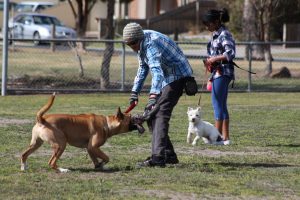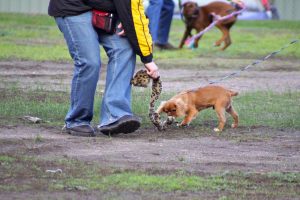MOTIVATIONAL TRAINING…

Working breed dogs such as Kelpies, Border Collies, Heelers, Terriers and any mixed breed with working lines – these dogs are almost always busy minded dogs and may exhibit an exhausting amount of energy and hyperactivity. And it doesn’t just end there….Boxers, Staffies, Labradors, Shepherds etc, the list goes on. Teaching some obedience skills to highly active dogs, espcially static exercises like sit/stays and drop/stays etc, can sometimes be the equivalent of sticking your finger in a meat processor (painful!). Some of these dogs often do better when trained using motivational based methods as opposed to conventional methods. This is because most of the conventional training methods may not be suited to the individual personalities and strong instincts, drives and activity level of these dogs.
A good example of the high level of activity, strong instincts and drives can be seen in most working dogs. These dogs have naturally strong instincts to chase, but with variations to their abilities. Some may also not be overly interested in food either as they would much prefer to chase a bird rather than sit there and wait for a treat. Further, what is most commonly found amongst these dogs is that they don’t like to be physically man-handled and therefore may not take well to “compulsion” style of training either.
These dogs also usually excel in sports such as agility, fly ball and other active dog sports. So how do we teach these very active dogs the simple yet ‘boring’ and necessary skills like sits, drops, stays and heeling, in a way that would be much more motivating for them?
Depending on what you are trying to achieve, one of the better methods for teaching active dogs is by way of “motivational play based training” methods. Motivational play training (aka ‘Training in Drive”) was first pioneered by trainers, Jack and Wendy Volhard, back in 1970 and is widely used today by so many obedience and sports trainers as rewards for their dogs because it works well.

“Motivational Play works with the dog’s drives, mainly the prey drive”
At Four Paws K9 Training, we use motivational play rewards with not just puppies but also with active adult dogs regularly in our classes. The change in the dog’s demeanour as their owners pull out the tug toy and reward the dogs with an exhuberant game of tug is amazing to watch. Magic happens as both the dog and owner enjoy the engagement that only motivational play provides. Even low energy dogs can be taught using this method, you just need to work on building the dog’s interest in the toy and game.
The beauty of this method is that you don’t suppress the dog’s instinctive drive, nor its energy levels, but rather gives this an outlet and direction. It creates happy, confident dogs that will be willing to do just about anything for you.
So go on…what are waiting for?? Grab that tug toy and get playing with your dog!!!

